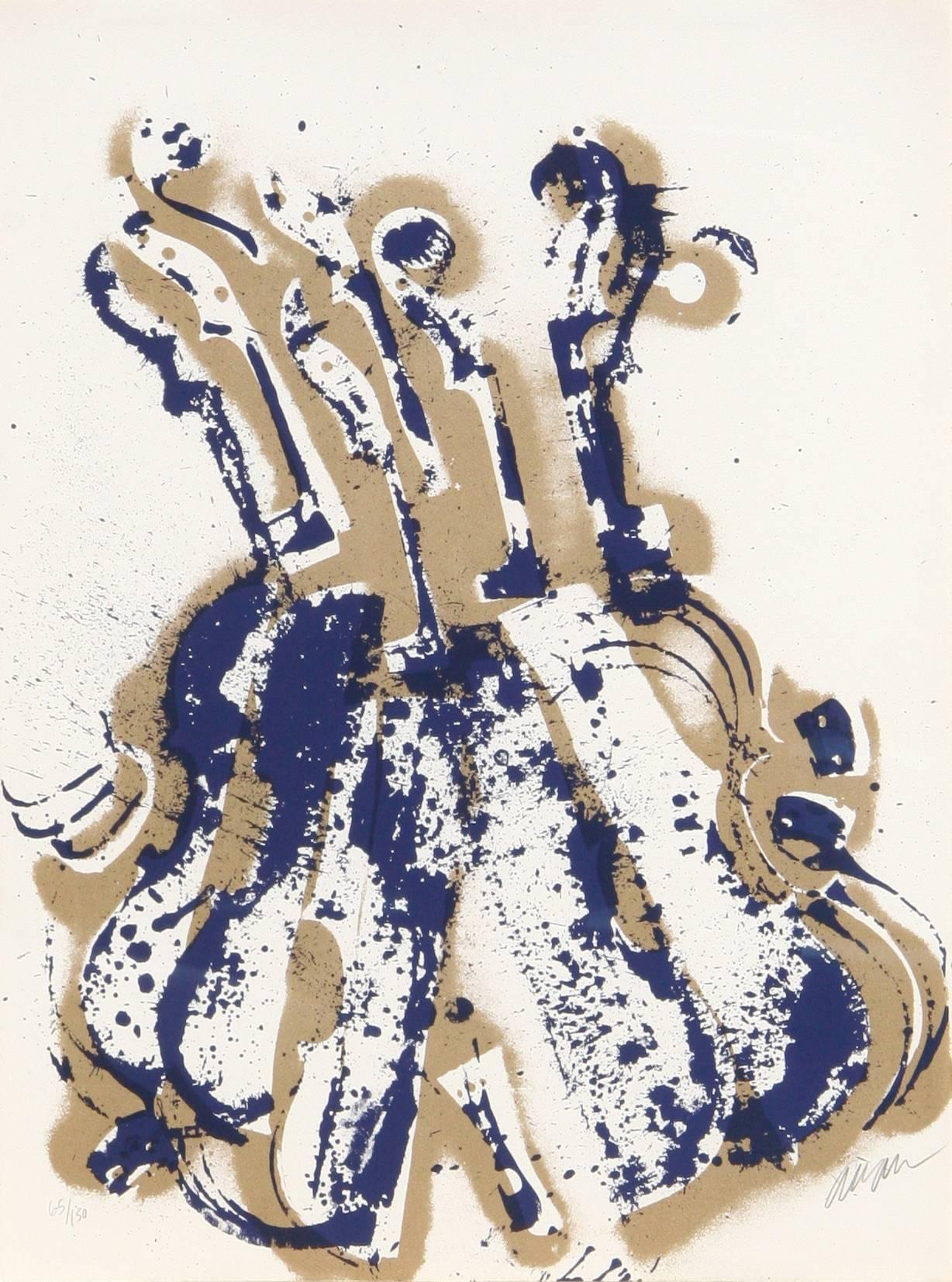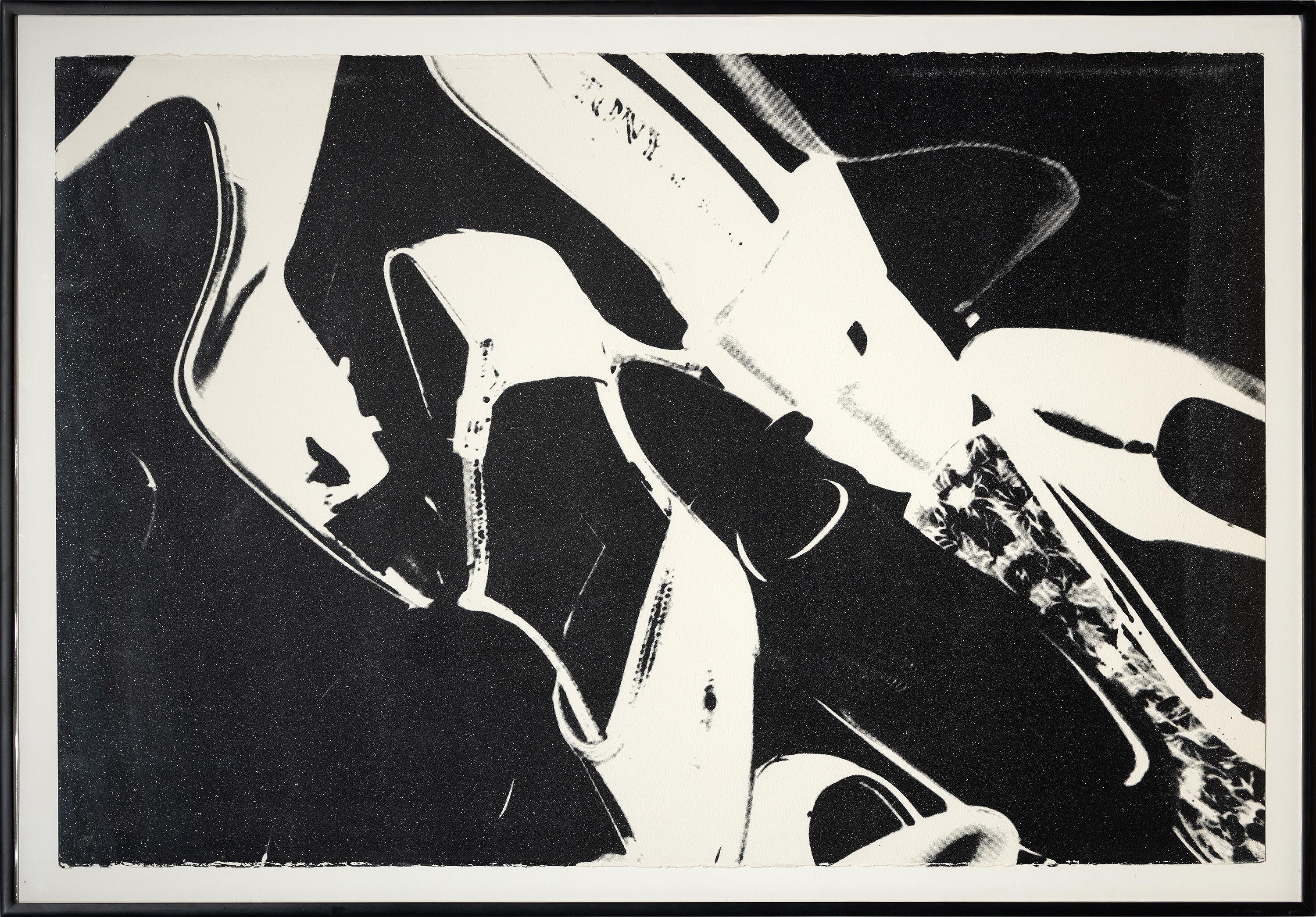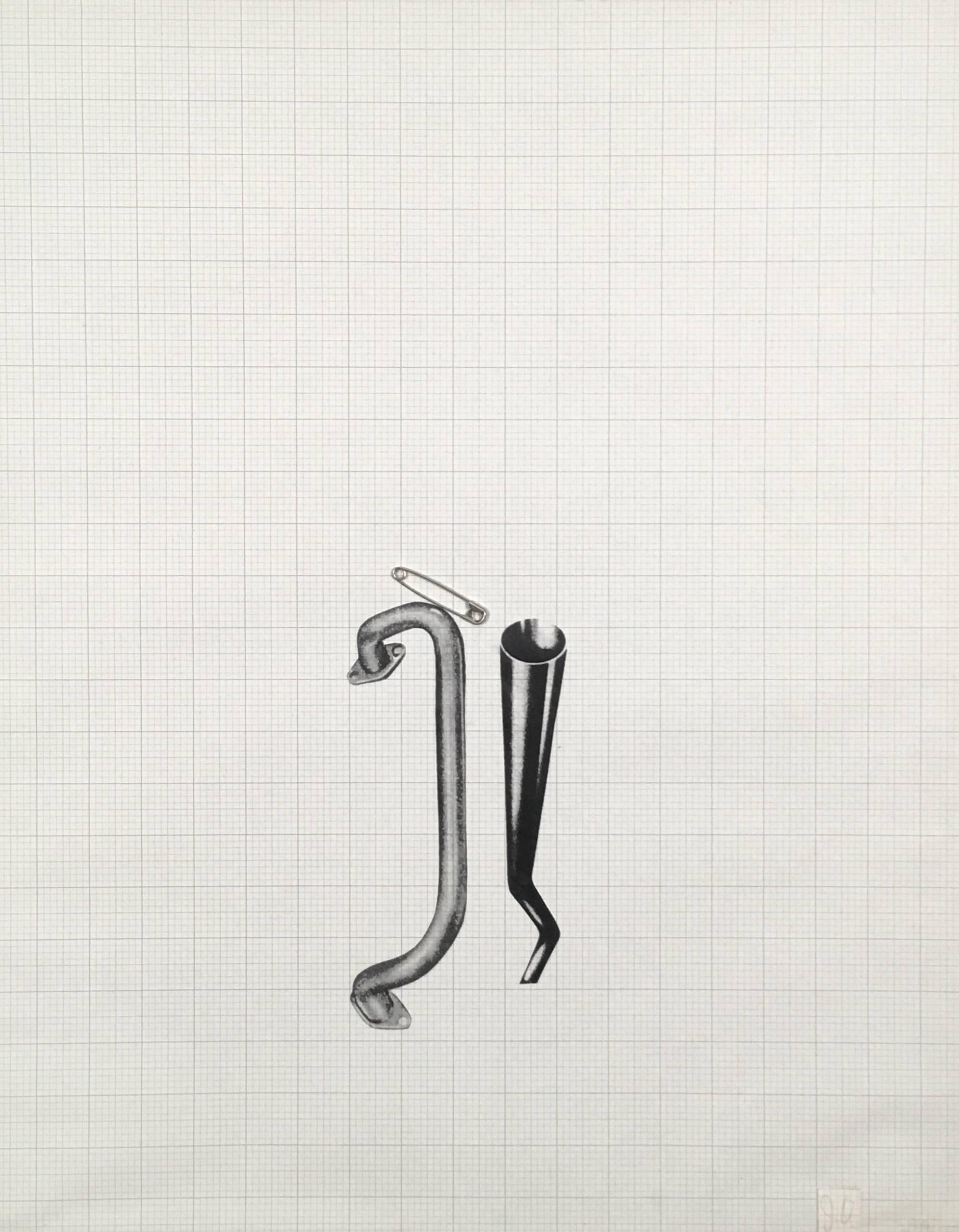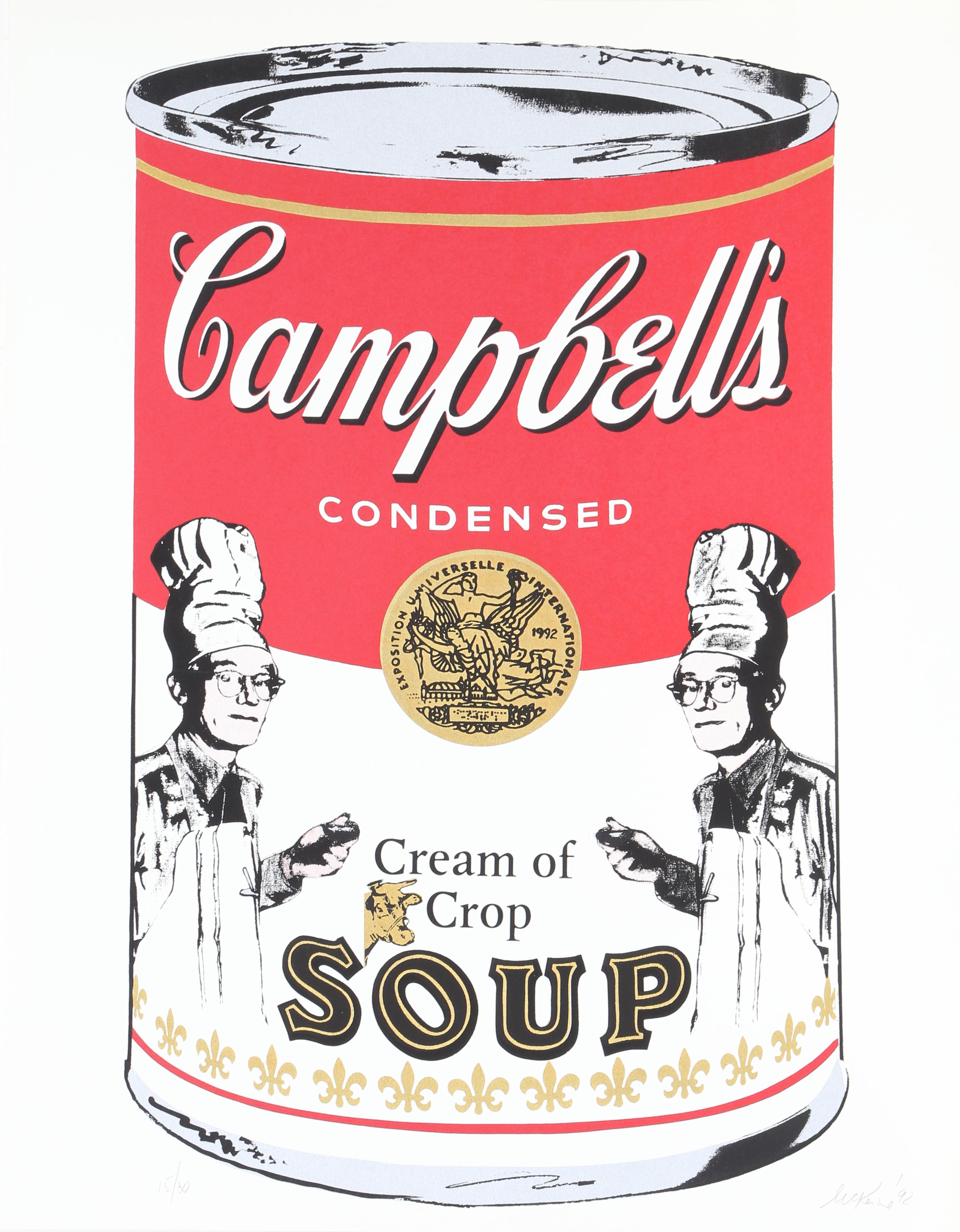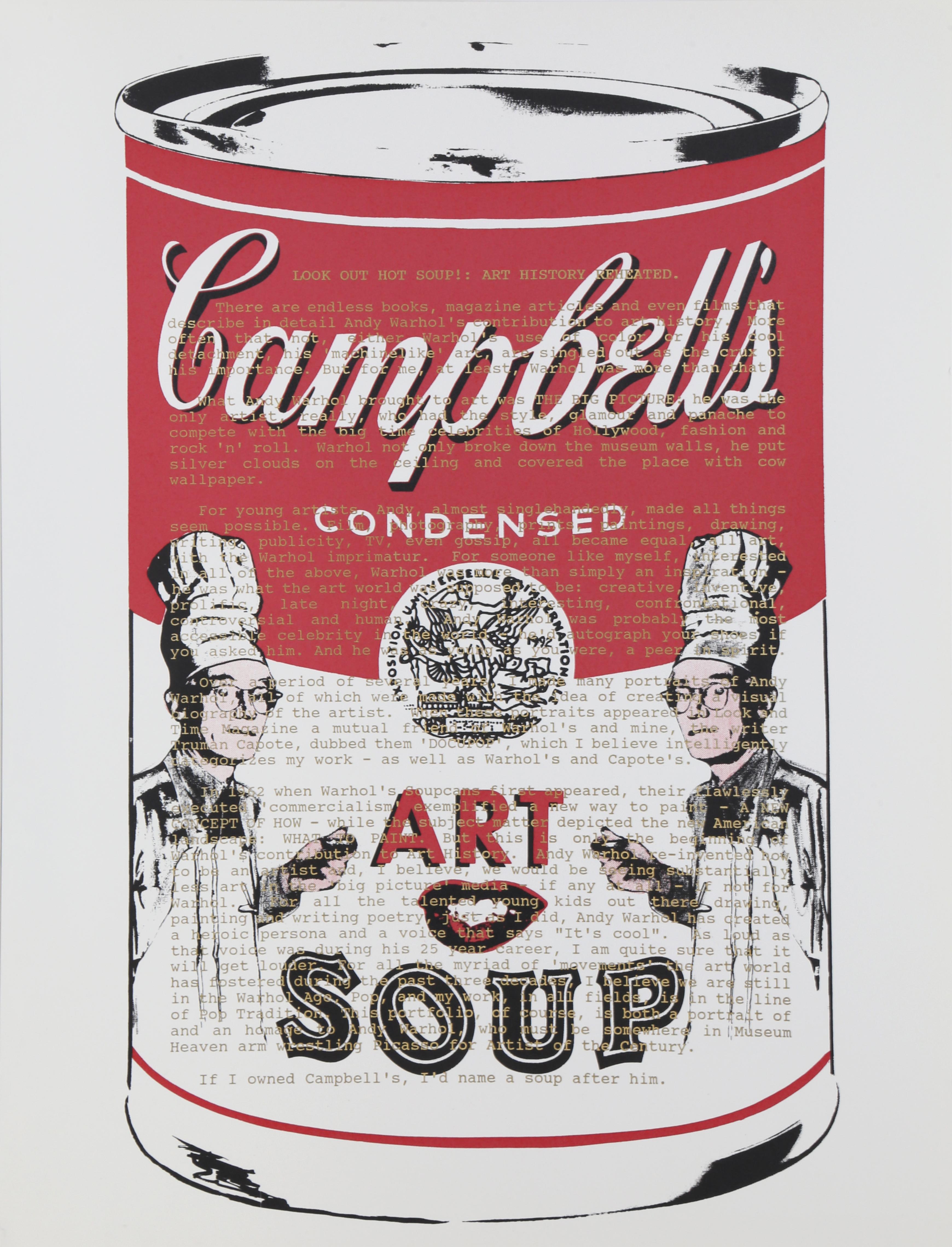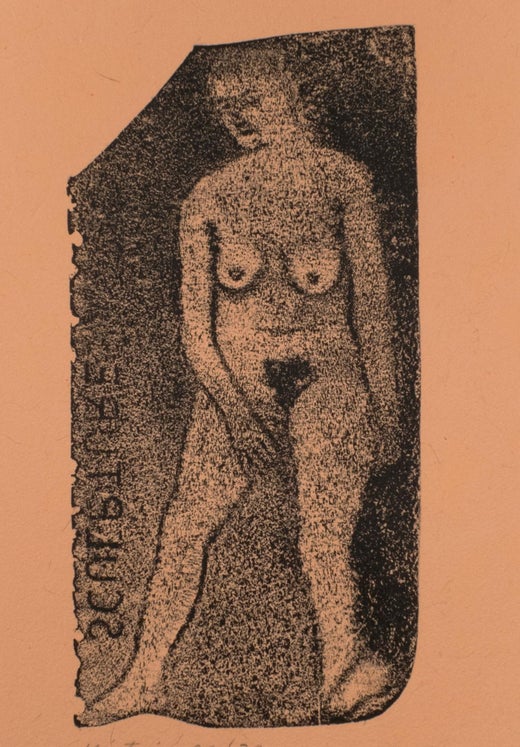Items Similar to R.B. Kitaj "The Jerwish Question"
Want more images or videos?
Request additional images or videos from the seller
1 of 6
Ronald Brooks KitajR.B. Kitaj "The Jerwish Question"1969
1969
About the Item
Initialled signed in pencil From R. B. Kitaj, In Our Time: Covers for a Small Library After the Life for the Most Part, screenprint 1969 edition of 150 photo screenprint. A cover of the infamous Henry Ford book from the Dearborn Independent "The Jewish Question".
Printed by Kelpra Studio, London, published by Marlborough AG, Schellenberg, Florida. The Jewish Museum. a cover related to Russian Soviet cinema and film.
Stylistically, these are hybrid works, influenced by Pop art and the modernist tradition of the Readymade, a work of art created when a mundane found object is named as an artwork and set in an art context. This avant-garde concept was originally invented by the Dada master Marcel Duchamp early in the twentieth century. In the 1960s it received renewed attention at a time when artistic norms were again being questioned. Reacting to Andy Warhol’s Pop imagery, Kitaj poignantly called his repurposed book covers “his soup can, his Liz Taylor.” The blatant use of images taken directly from commercial sources situates In Our Time as a precursor of appropriation art. In turning book covers into works of art, Kitaj is offering fragments of a history of knowledge, in which the content of each volume is at once mysterious and absent. Coming from this passionate bibliophile, the series is nothing less than an intellectual self-portrait.
R.B. Kitaj, in full Ronald Brooks Kitaj . Ron Kitaj was born in Ohio, USA in 1932. American-born painter noted for his eclectic and original contributions to Pop art. He became a merchant seaman with a Norwegian freighter when he was 17. He studied at the Akademie der Bildenden Kunste in Vienna and the Cooper Union in New York. After serving in the United States Army for two years, in France and Germany, he moved to England to study at the Ruskin School of Drawing and Fine Art in Oxford and then the Royal College of Art in London, alongside David Hockney, Allen Jones and Patrick Caulfield. Kitaj was recognised as being one of the world's leading draftsmen, almost on a par with, or compared to, Degas. Indeed, he was taught drawing at Oxford by Percy Horton, himself a pupil of Walter Sickert, who was a pupil of Degas; and the teacher of Degas studied under Ingres.
Kitaj had a significant influence on British Pop art and was recognised as being one of the world’s leading draughtsmen. In his later years he developed a greater awareness of his Jewish heritage, considering himself to be a ‘wandering Jew’. He was awarded Royal Academician in 1991 and Golden Lion at the Venice Biennale in 1995. Examples of his work are held in most major public collections worldwide. Kitaj was elected to the Royal Academy in 1991, the first American to join the Academy since John Singer Sargent. He received the Golden Lion at the Venice Biennale in 1995. He staged another exhibition at the National Gallery in 2001, entitled "Kitaj in the Aura of Cézanne and Other Masters".
In September 2010 Kitaj and five British artists including Howard Hodgkin, John Walker, Ian Stephenson, Patrick Caulfield and John Hoyland were included in an exhibition entitled The Independent Eye: Contemporary British Art From the Collection of Samuel and Gabrielle Lurie, at the Yale Center for British Art.
Kitaj was associated with the beginnings of the Pop art movement in Great Britain in the early 1960s. His works mingled the impersonal finish characteristic of Pop canvases with the loose, painterly brushwork of Abstract Expressionism but differed from the work of his Pop contemporaries in their complex and allusive figurative imagery. Kitaj’s semi abstract paintings feature brightly coloured and imaginatively interpreted human figures portrayed in puzzling and ambiguous relation to one another. His work was highly intellectual in its wealth of pictorial references to historical, artistic, and literary topics. Kitaj continued to exhibit widely throughout the 1960s and ’70s while teaching painting at various British fine arts schools. In his later years, he developed a greater awareness of his Jewish heritage, which found expression in his works, with reference to the Holocaust and influences from Jewish writers such as Franz Kafka and Walter Benjamin, and he came to consider himself to be a "wandering Jew". In 1989, Kitaj published "First Diasporist Manifesto", a short book in which he analysed his own alienation, and how this contributed to his art.
He staged a major exhibition at Los Angeles County Museum of Art in 1965, and a retrospective at the Hirshhorn Museum in Washington D.C. in 1981. He selected paintings for an exhibition, "The Artist's Eye", at the National Gallery, London in 1980.
- Creator:Ronald Brooks Kitaj (1932-2007, American)
- Creation Year:1969
- Dimensions:Height: 19.97 in (50.7 cm)Width: 13.59 in (34.5 cm)
- Medium:
- Movement & Style:
- Period:
- Condition:
- Gallery Location:Surfside, FL
- Reference Number:1stDibs: LU38210505722
Ronald Brooks Kitaj
Born in Cleveland, Ohio in 1932, R.B. (Ronald Brooks) Kitaj is considered a key figure in European and American contemporary painting. While his work has been considered controversial, he is regarded as a master draftsman with a commitment to figurative art. His highly personal paintings and drawings reflect his deep interest in history; cultural, social and political ideologies; and issues of identity. Among his various honors are election to the American Academy of Arts and Letters in 1982, and election to the Royal Academy in 1985 (the first American since John Singer Sargent to receive this honor.) Numerous retrospective exhibitions of his work include shows at the Hirshhorn Museum in Washington, D.C.; The Jewish Museum, Berlin; The Jewish Museum, London; and the Hamburger Kunsthalle in Germany. Raised in Cleveland, Ohio, and Troy, New York, Kitaj joined the Merchant Marines in 1949.
In 1950, between sailings, he attended classes at the Cooper Union for the Advancement of Science and Art in New York. He went on to study drawing at the Academy of Fine Art in Vienna, Austria. Kitaj moved to Oxford, England in 1957, and enrolled at The Ruskin School of Drawing and Fine Art, University of Oxford. In 1959, Kitaj was accepted into Royal College of Art, London, where he befriended classmate David Hockney. Upon graduation from the RCA, Kitaj signed with Marlborough Fine Art, London, where he had his first solo exhibition in 1963. His art career began in earnest, and he found critical acclaim alongside commercial success. A second solo show followed at Marlborough Gallery, New York, in 1965, and he sold “The Ohio Gang” to The Museum of Modern Art. In 1969, Kitaj taught for a year at the University of California, Los Angeles. In 1976, he coined the term “School of London” in an essay he wrote as curator of the polemical exhibition, “The Human Clay,” at the Hayward Gallery, London. The term, though loose, continues to define a group of stylistically diverse artists, including Kitaj, who were working in London at that time focusing on figural representation. In 1981, he spent a year in Paris, France, where he focused on drawing and use of pastel. In 1994, the Tate Gallery, London, organized a major retrospective of Kitaj’s work. Hostile and personal attacks from some critics led to what Kitaj referred to as the “Tate War.” The exhibition subsequently traveled to the Los Angeles County Museum of Art and the Metropolitan Museum of Art, New York. Kitaj moved to Los Angeles, California, and continued to exhibit with Marlborough Fine Art and the Marlborough Gallery, New York. In 2001 the National Gallery London organized a solo exhibition of paintings: “R.B. Kitaj In the Aura of Cezanne and Other Masters.” Kitaj focused on his “late style” in his Yellow Studio in Westwood and died in 2007. His gift of his archive to the UCLA Library Special Collections was celebrated with exhibitions at the Skirball Cultural Center and UCLA’s Young Research Library.
About the Seller
4.9
Platinum Seller
These expertly vetted sellers are 1stDibs' most experienced sellers and are rated highest by our customers.
Established in 1995
1stDibs seller since 2014
1,560 sales on 1stDibs
Typical response time: 1 hour
- ShippingRetrieving quote...Ships From: Surfside, FL
- Return PolicyA return for this item may be initiated within 3 days of delivery.
More From This SellerView All
- R.B. Kitaj Screenprint Collage Hand Signed British Pop Art Film Still CamelBy Ronald Brooks KitajLocated in Surfside, FLThe Most Important Film Ever Made, 1972 Color screen print and collage, from the edition of 70. 15 x 17 in 38.1 x 43.2 cm Published by the artist with Marlborough Graphics at the Kelpra studio in 1972. This work is also in the collections of TATE London and the Victoria & Albert Museum. the price reflects the fact that there is no backing page. Stylistically, these are hybrid works, influenced by Pop art and the modernist tradition of the Readymade, a work of art created when a mundane found object is named as an artwork and set in an art context. This avant-garde concept was originally invented by the Dada master Marcel Duchamp early in the twentieth century. In the 1960s it received renewed attention at a time when artistic norms were again being questioned. Reacting to Andy Warhol’s Pop imagery, Kitaj poignantly called his repurposed lithograph and silkscreen book covers “his soup can, his Liz Taylor.” The blatant use of images taken directly from commercial sources situates In Our Time as a precursor of appropriation art. In turning book covers into works of art, Kitaj is offering fragments of a history of knowledge, in which the content of each volume is at once mysterious and absent. Coming from this passionate bibliophile, the series is nothing less than an intellectual self-portrait. R.B. Kitaj, in full Ronald Brooks Kitaj . Ron Kitaj...Category
1960s Pop Art Still-life Prints
MaterialsScreen
- Vintage Original Poster Sister Corita Kent Lithograph Pop Art "Life Without War"By Mary Corita (Sister Corita) KentLocated in Surfside, FLCorita Kent (American, 1918 - 1986)"We Can Create Life without War" Corita Billboard Peace Project Poster 1985 Corita Billboard Event - Part of Peace Week, January 17-24, 1985 San Lu...Category
1980s Pop Art Abstract Prints
MaterialsLithograph, Screen, Offset
- Large Donald Saff Surrealist Pop Art Aquatint Etching Bee, Chair, PotBy Donald SaffLocated in Surfside, FLArtist: Donald Saff Medium: Etching with Aquatint, Hand signed and numbered in pencil Donald Jay Saff (born 12 December 1937) is an artist, art historian, educator, and lecturer, specializing in the fields of contemporary art in addition to American and English horology. Saff was born in Brooklyn, New York. Donald Saff began his undergraduate degree at Queens College, City University of New York, in 1955, initially envisioning a career as an electrical engineer. However, the following year Saff changed his major to art and learned printmaking, to graduate with a B.A. in 1959 and a M.A. in art history from Columbia University in 1960. In the years following, Saff was awarded a M.F.A. from Pratt Institute in 1962 and an Ed.D. in studio art and art history from Columbia University in 1964. In his early career, Saff studied with Robert Goldwater, Robert Branner, Louis Hechenbleikner, and Meyer Schapiro. Saff is primarily known for his work and collaboration with the leading artists of the late-twentieth century, including Robert Rauschenberg, Jim Dine, Roy Lichtenstein, James Rosenquist, Nancy Graves, Philip Pearlstein, and James Turrell. Saff's prolific career is the subject of Marilyn S. Kushner's book, Donald Saff: Art in Collaboration (2010). Saff began his teaching career at Queens College as a lecturer in Art History, Design, and Drawing, from 1961 to 1964. In 1965, Saff was appointed as an associate professor in the visual arts department of the University of South Florida in Tampa, Florida, and became professor and chairman of the visual arts department two years later. In 1971, Saff became the founding dean of the College of Fine Arts at U.S.F., and was awarded the rank of distinguished professor at the university in 1982. Saff was later named dean emeritus by USF in 1989, and distinguished professor emeritus in 1996. In 1999, Saff was awarded the honorary degree of Doctor of Fine Arts at U.S.F. He was appointed the Director of Capital Projects of the Solomon R. Guggenheim Foundation, New York, in 2001, followed by the appointment of Senior Curator of Prints and Drawings in 2002. In 1968, Saff founded Graphicstudio at U.S.F. through funding by a seed grant from the Florida Arts Council and community supporters; the following year, Philip Pearlstein was the first artist invited to Graphicstudio to collaborate with Saff and his team. Saff became Founding Dean of the College of Fine Arts at U.S.F. in 1971. Under Saff's directorship, Graphicstudio collaborated with artists such as James Rosenquist, Robert Rauschenberg, Richard Anuszkiewicz, Shusaku Arakawa, Jim Dine, Lee Friedlander, Nancy Graves, Ed Ruscha, and Roy Lichtenstein. The collection of Graphicstudio is archived in the National Gallery of Art in Washington, D.C. Graphicstudio was founded by Dr. Donald Saff as part of the renaissance in American printmaking in the 1960s, in the company of studios such as ULAE, Tamarind, and Gemini GEL. This renaissance brought artists involved in the Pop art movement, such as Robert Rauschenberg, James Rosenquist, and Jim Dine, together with a growing number of trained printmakers from around the world. After Saff retired from U.S.F., he continued to collaborate with these artists, as well as James Turrell, at Saff Tech Arts in Oxford, Maryland, which was established in 1991. While Saff and Rauschenberg were traveling in China, Rauschenberg conceived of the Rauschenberg Overseas Culture Interchange (ROCI) in 1982, which began in 1984 with Saff as the artistic director. Saff travelled to over twenty countries and met with poets and writers in order to decide which were the most appropriate venues for the show and prepare for Rauschenberg's visit and exhibition. In recent years, Saff has continued to lecture and write on art and the history and mechanics of nineteenth-century clocks; in particular, the work of Charles Fasoldt, in addition to the development of time distribution from the Harvard College Observatory, and the horological innovations of Richard F. Bond. He has lectured on Fasoldt for the Antiquarian Horological Association in Cincinnati, OH (2001), the National Association of Watch and Clock Collectors in Pittsburgh, PA, and Anheim, CA (2003), and at the 26th Annual Ward Francillon Time Symposium in Houston, TX (2004), among other venues. Saff continues to work with the Royal Observatory in Greenwich, collaborating with Jonathan Betts and Rory McEvoy, on the trials of Burgess Clock B. (See "Honors.") Exhibitions Saff's individual work spans across his career of collaborative art. As early as 1965, Saff produced Duino Elegies, a print suite that was published and exhibited by Martin Gordon Gallery in New York and at the Galleria Academia in Rome; it was acquired by the Library of Congress, the Brooklyn Museum, and Lessing Rosenwald. Saff also collaborated with printers Galli and Arduini in Urbino to create print suites Breezes (1969), exhibited and published by the Martin Gordon Gallery. Additionally, Saff collaborated with Galli on print suites Paradise Lost (1970) and Numbers (1972), the former printed in Tampa, FL, and exhibited at the Martin Gordon Gallery, the University of South Florida Gallery, the Toronto Art Gallery, and the Loch Haven Art Center, FL. Numbers was exhibited at Multiples Gallery, New York. In 1979, Saff produced print suite Fables that was published and exhibited by the Getler/Pall Gallery in New York, followed by the print suite Constellations (1980), which was also exhibited at the Tom Lutrell Gallery in San Francisco. In 1981, Saff had solo exhibitions of his artwork in the Galleria d'Arte Moderna in Udine, Italy, Youngstown State University, OH, the Leo Castelli Gallery, NY, and in "Recent Acquisitions" at The Museum of Modern Art, NY. Additionally, Saff had solo exhibitions at Dyansen Gallery, NY (1982), at I. Feldman Gallery, Sarasota (1983), and at Edison Community College, FL (1988). In 1989, the retrospective Donald Saff: Mixed Metaphors, 1956–1989 was held at the Tampa Museum of Art and traveled to the Virginia Beach Center for the Arts, followed by his solo exhibition Winged Metaphors: Sculpture and Prints by Donald Saff at the Barbara Gillman Gallery in Miami later that year. In 1997, Brenau University Galleries exhibits Poetics: The Work of Donald Saff in Gainesville, GA. The same year, the Tampa Museum of Art exhibited Donald Saff/Robert Rauschenberg: In Collaboration. Finally, the Academy Art Museum in Easton, MD, exhibited Donald Saff: Gravity and Constellations; Selected Works in 2006. Honors Saff was awarded a Teaching Fellowship at Queens College (1960), a Yaddo Fellowship, Saratoga Springs, NY (1963), and Fulbright Fellowship (1964) to Italy where he studied at Istituto Statale di Belle Arti. While in Urbino, Saff met lifelong friend and colleague Deli Sacilotto, with whom he would co-author Printmaking: History and Process (1978) and Screenprinting: History and Process (1979). He received the Governor's Award for the Arts from the State of Florida in 1973, and was awarded the Florida Endowment for the Arts Individual Artist Grant in 1980. In 1997, Saff was awarded the title "Printmaker Emeritus" by the 25th Southern Graphics Council Conference in Tampa, F.L. In 2002, he was appointed as Visiting Distinguished Professor of Rhode Island School of Design. In April 2015, Saff was awarded a certificate from the Guinness World Records for his work on completing the world's most accurate pendulum clock, "Clock B", which was started by Martin Burgess in 1975. The official title awarded by Guinness World Records, as "the most accurate mechanical clock with a pendulum...Category
1980s Pop Art Figurative Prints
MaterialsEtching, Aquatint
- Triptychos Post Historicus Picasso Conceptual Art Silkscreen Gold LithographLocated in Surfside, FLBraco D. Slobodan "Braco" Dimitrijević (born 18 June 1948) is a Paris-based Bosnian and Yugoslavian conceptual artist. His works deal mainly with history and the individual's place ...Category
1980s Conceptual Still-life Prints
MaterialsLithograph, Screen
- Set of Eyes, Color Lithograph, Belgian Abstract Expressionist Tamarind PrintBy Dirk de BruyckerLocated in Surfside, FLSigned, dated and titled. Initialed and dated lower right, each numbered 8/20, lower left. 9 x 6 image size, 22 x 15 in. sheet size. With the blindstamp of the Tamarind Institute pri...Category
1990s Abstract Expressionist Abstract Prints
MaterialsLithograph, Archival Paper
- Large Bold Colorful Monoprint Painting Floral in Vase February Amaryllis FlowersBy Gary BukovnikLocated in Surfside, FLImage is 48 X 36 inches. Still life of flowers in a vase. In bold red, orange green and yellow color. Born and educated in Cleveland, Gary Bukovnik has lived in San Francisco for m...Category
1990s American Modern Still-life Paintings
MaterialsMonoprint
You May Also Like
- Yves Klein's Violins, Musical Screenprint by ArmanBy ArmanLocated in Long Island City, NYArtist: Arman, French (1929 - 2005) Title: Yves Klein's Violins Year: 1979 Medium: Screenprint on Arches Paper, signed and numbered in pencil Edition: 150 Size: 30 in. x 22 in....Category
1970s Pop Art Still-life Prints
MaterialsScreen
- Diamond Dust Shoes (Black and White)By Andy WarholLocated in Palm Desert, CA"Diamond Dust Shoes (Black and White)" is a screen print by American pop artist Andy Warhol. It is signed and editioned verso, " 18/60 Andy Warhol" Stamped verso, "© Andy Warhol 1980...Category
1980s Pop Art Still-life Prints
MaterialsScreen
- Jim Dine, "Toolbox VII", hand signedBy Jim DineLocated in Chatsworth, CAThis piece is an original silkscreen collage on graph paper done in 1966. It is hand initialed "J.D." on the front right corner and numbered 14/150 on the back. This piece measure...Category
1960s Pop Art Still-life Prints
MaterialsScreen, Mixed Media
- PearsBy Donald SultanLocated in San Francisco, CAArtist: Donald Sultan (American, born 1951) Title: Pears Year: 1989 Medium: Color silkscreen and lithograph Edition: Numbered 87/125 in pencil Paper: Arches 88 Image size: 12 x 12 inches paper size: 22 x 23 inches Signature: Hand signed in pencil by the artist Publisher : Parasol Editions Press L.T.D. Portland, Oregon. Condition: Excellent Frame: Framed in a custom wooden maple frame, with fabric bevel and matting. Description: From the suite, Fruits Donald Sultan is an American painter, sculptor, and print maker, well-known for large-scale still life paintings and the use of industrial materials such as tar, enamel, spackle and vinyl tiles. He has been exhibiting internationally in prominent museums and galleries, and his works are included in important museum collections all over the globe. Donald Sultan rose...Category
Late 20th Century Pop Art Figurative Prints
MaterialsScreen
- Campbells Soup, Silkscreen by Mike McKenzieBy Mike McKensieLocated in Long Island City, NYArtist: Mike McKenzie, American (1954 - ) Title: Cream of the Crop (Campbell's Soup Can) Year: circa 1992 Medium: Silkscreen, signed and numbered in pencil Edition: 15/30 Size: 26 x ...Category
1990s Pop Art Still-life Prints
MaterialsScreen
- Campbells Soup with Text, Pop Art Silkscreen by Mike McKensieBy Mike McKensieLocated in Long Island City, NYArtist: Mike McKenzie, American (1954 - ) Title: Campbells Soup with Text Year: circa 1992 Medium: Silkscreen Size: 26 x 20 in. (66.04 x 50.8 cm)Category
1990s Pop Art Still-life Prints
MaterialsScreen
